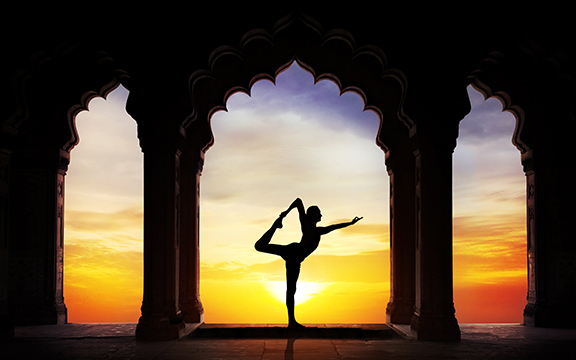 The sages advised that since, in Kali Yuga, humankind is preoccupied with the body, an important sadhana or spiritual practice for this age is Hatha Yoga—the science of achieving higher consciousness through the disciplines of body and breath. In this article, the director and the chairman of the International Centre for Yoga Education and Research (Pondicherry, India) offer an informative overview of the science of Hatha Yoga, its practices, and its three major texts.
The sages advised that since, in Kali Yuga, humankind is preoccupied with the body, an important sadhana or spiritual practice for this age is Hatha Yoga—the science of achieving higher consciousness through the disciplines of body and breath. In this article, the director and the chairman of the International Centre for Yoga Education and Research (Pondicherry, India) offer an informative overview of the science of Hatha Yoga, its practices, and its three major texts.
The word “Hatha” is composed of two syllables: “Ha,” which refers to the solar, positive, warm, activating energies and “tha” which refers to the lunar, cooling, negative, inhibitive energies. Hatha Yoga thus becomes a method of creating a harmonious interaction or polarity between these two powerful, dialectically opposed primordial universal energies. The dominant right side of the body is harmonized with the more passive left side.
The creative, intuitive, visionary right side of the bi-cameral brain is “yoked” harmoniously with the logical, rational, mathematically inclined left side of the brain. A polarized duality is transformed into a harmonious unity and the human personality becomes integrated. Then, real Yoga or union occurs spontaneously. Only when an individual exists in a perfect polarity of prana–apana, can the highest experience—samadhi—occur.
In four-fold awareness, one must first become aware of the body. The second awareness is of the emotions, senses, and energy. The third awareness is awareness of the mind. The fourth awareness is of awareness itself. Good Hatha Yoga fosters deep awareness of the body inside-outside, right side-left side and top side-bottom side. The practices stimulate deep consciousness in every cell. This awareness spills over into an awareness of emotions, sensations and energy (prana flows). The awareness deepens into an awareness of the working of the mind and how body, emotions, sensations, and prana are inseparably linked together.
Swami Gitananda noted that, “All of the evolutionary history of life on this earth planet is contained in your brain. You have a reptilian brain and a mammalian brain, in common with those lower life forms and all their primordial instincts for survival: sexual drive, dominance, territoriality, etc. are also active there. Then, you have the cerebral cortex, the human brain, which is no longer bound by instinct, but can make conscious choices. The problem facing human beings today is the lack of communication between this old, unconscious brain and the new conscious brain. Hatha Yoga is the superb technology that enables us to bridge that gap.”
This is the reason why the ancient rishis taught their disciples to put their bodies into positions resembling life forms like trees, mountains, insects, birds and animals. The body remembers those past incarnations consciously when locked back into a form resembling those physical structures. By becoming conscious of the unconscious, the individual develops the perspective necessary to view with vairagya (detachment) all the old animal and reptilian conditionings. This detached witnessing puts space between stimulus and response so we can choose consciously how to respond to situations rather than react with the animal response of flight or fight.
Hatha Yoga and Its Texts
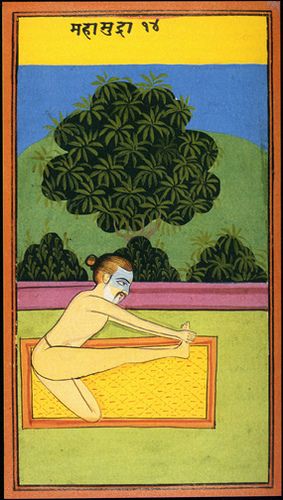 In Vedic times, the goal of the refined human was to seek moksha, freedom from human birth and mergence in Cosmic Consciousness. Asana meant a seated position or a seat. The word asana is found in the Bhagavad Gita and is used to mean “a seat,” “a place to sit” or “a seated position.” The only physical instruction Lord Krishna gives Arjuna is “to sit straight, with head and neck erect.” Indian pandits date the Bhagavad Gita as being at least 5,000 years old.
In Vedic times, the goal of the refined human was to seek moksha, freedom from human birth and mergence in Cosmic Consciousness. Asana meant a seated position or a seat. The word asana is found in the Bhagavad Gita and is used to mean “a seat,” “a place to sit” or “a seated position.” The only physical instruction Lord Krishna gives Arjuna is “to sit straight, with head and neck erect.” Indian pandits date the Bhagavad Gita as being at least 5,000 years old.
The next time the word asana appears, with significance, is in the Yoga Sutras of Patanjali (about 800 BCE). Patanjali simply says that asana is the third of eight steps to liberation and is a body posture that is sthira sukham (comfortable and steady). The original meaning of the word asana could be derived from the root, “asi,” which means, “to be.” Hence, asana is a body position that enables the seeker to discover his or her true being (divinity) by remaining still and silent.
About 500 AD, the emphasis of spirituality and Yoga started to shift more toward physical practices and techniques in keeping with the materialistic, sensual, body-oriented nature of humankind in Kali Yuga. Certain yogic practices evolved out of the Atharva Veda and the Tantric tradition, which used the body itself as an instrument of sadhana (spiritual practice). Though these techniques were written down, they were written in a coded language, making it impossible for the uninitiated to understand. From about 500 AD to about 1500 AD, several scriptures were recorded, which are commonly known as the Hatha Yoga scriptures. These include the Goraksasatakam, the Gheranda Samhita and Hatha Yoga Pradipika.
Goraksasatakam
This scripture was composed in 100 verses by the Rishi Goraksha, who lived about fifteen hundred years ago. He preached the ideal of samaradhya, or the “sweetest and most perfect adjustment and harmony in one’s life experience.” Verse 4 defines the subject matter of Yoga: “The six limbs of Yoga are asana, pranayama, pratyahara, dharana, dhyana and samadhi.” The entire text describes how these limbs may be achieved. Goraksha comes close to the Vedic ideal by emphasizing complete control of the physical organism and mental steadiness as the prelude to experiencing non-duality on the highest spiritual plane. He says there are 8.4 million asanas.
This idea is also found in the Shiva Samhita, which says that the particular form of each living creature is an asana, as Lord Shiva holds still for a moment in his cosmic dance. Thus, there are 8.4 million species. Shiva has enumerated 84 important asanas. Sage Goraksha says that of these, two asanas are important, namely, siddhasana and kamalasana, which are both sitting meditative poses.
Rishi Goraksha gives detailed information on the chakras, or vortexes of spiritual energy, located in the human energy field. He also teaches that there are thousands of nadis (subtle nerves), which serve as the pathways for prana. Of these pathways, he says 72 are important. The three most important nadis are ida (left side, whose deity is the moon); pingala (right side whose deity is the sun) and sushumna (center whose deity is agni or fire). He also describes the types of prana, circulating in various parts of the human force field.
Rishi Goraksha also teaches about Kundalini Shakti: “She lies above the kanda, folded eight times, always closing up, by her mouth, the entrance to the Brahmarandhra” (Goraksasatakam, 30). Rishi Goraksha also describes pranayama practices, emphasizing puraka, rechaka and kumbhaka (inhalation, exhalation and retention). This is also dealt with in the system of concentration, or dharana, taught by Rishi Goraksha, which includes contemplation upon the various mandalas for the pancha maha bhutas of earth, water, fire, air and ether. The sage also describes samadhi, or cosmic consciousness. He defines this highest spiritual state as, “When the prana becomes stilled and the mind is absorbed, there results the identification of jivatma and paramatma, which is called samadhi” (Goraksasatakam, 94). The measurement of the time duration needed for the state of dharana to slip into samadhi is also given in detail.
Gheranda Samhita
This exact date of this scripture is unknown, though it is believed to be from the latter part of the seventeenth century. It is written in the form of a dialogue between Gheranda, the preceptor, and Chandakapali, the disciple. Though it is a treatise of Hatha Yoga, it does not use the word “Hatha.” Instead, it calls the type of Yoga discussed in the treatise, “Ghatastayoga.” This term is not found in any other text on Yoga. “Ghata” in this sense refers to the “body,” and its literal meaning in Sanskrit also is “a pot.”
This suggests that the malleable clay of the body can be formed and fired by the practices of Yoga to make it a fit container to hold the waters of liberation. A beautiful statement by this rishi is as follows: “There are no fetters like those of illusion (maya); no strength like that which comes from discipline (Yoga); there is no friend higher than knowledge (jnana) and no greater enemy than egoism (ahamkara)” (GS 1.4).
Whereas Yogamaharishi Patanjali calls Yoga Ashtanga, (eight limbs) and Rishi Goraksha calls Yoga Shadanga, (six limbs); Rishi Gheranda enunciates Saptayoga (seven limbs of Yoga). According to this revered rishi, the seven exercises for making the body fit for divine wisdom are: purificatory, strengthening, steadying, calming and those leading to lightness, perception and isolation (GS 1.9). Rishi Gheranda classifies the Yoga practices as kriyas (dhautis, bastis, neti, trataka, nauli, kapalabhatis), asanas, mudras, pratyahara, pranayama, dhyana and samadhi. Great emphasis is given to the purification practices which are quite elaborate.
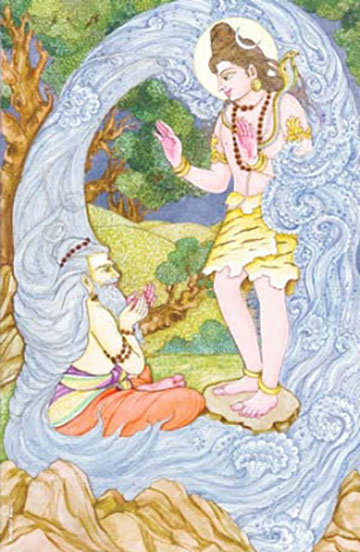 Asanas have been described in great detail in this work. Again we find the concept of 8.4 million asanas enumerated by Lord Shiva. There are as many asanas as there are creatures on earth (GS 2.1). Among these, said the rishi, 84 are best, and of those 84, 32 have been found useful for humankind. The 32 asanas recorded by Rishi Gheranda are:
Asanas have been described in great detail in this work. Again we find the concept of 8.4 million asanas enumerated by Lord Shiva. There are as many asanas as there are creatures on earth (GS 2.1). Among these, said the rishi, 84 are best, and of those 84, 32 have been found useful for humankind. The 32 asanas recorded by Rishi Gheranda are:
Sidda (perfect posture), padma (lotus posture), bhadra (gentle posture), mukta (free posture), vajra (adamant posture), svastika (prosperous posture), sinha (lion posture), gomukha (cow-mouth posture), vira (heroic posture), dhanur (bow posture), mrita (corpse posture), gupta (hidden posture), matsya (fish posture), matsendra, goraksha, paschimottana, utkata (hazardous posture), sankata (dangerous posture), mayura (peacock posture), kukkuta (cock posture), kurma (tortoise posture), uttana manduka, uttana kurmaka, vriksha (tree posture), manduka (frog posture), garuda (eagle posture), vrisha (bull posture), salabha (locust posture), makara (dolphin posture), ushtra (camel posture), bhujanga (snake posture), Yoga mudra (gesture of Yoga).
Twenty-five mudras are discussed, and afterward, Lord Shiva is quoted as telling Devi, “O Devi. I have told you all the mudras. Their knowledge leads to adeptship. It should be kept secret with great care and should not be taught indiscriminately to everyone. This gives happiness to the yogis.” Again we see the idea that Yoga knowledge should be kept secret.
This rishi also discusses pratyahara and pranayama techniques, laying emphasis first on the purification of the nadis, asking, “Vayu [deity of the air] cannot enter the nadis so long as they are full of impurities. How then can pranayama be accomplished? First, the nadis should be purified.”
Sage Gheranda also discusses dhyana and samadhi in detail: “Dhyana, or meditation, is of three kinds: gross, subtle, and luminous. When a particular figure, such as one’s Guru or deity is contemplated, it is sthula or gross; when Brahman or prakriti is contemplated as a mass of light it is called jyothi meditation; when Brahman as a bindu (point) and kundalini force is contemplated, it is sukshma or subtle meditation” (GS 6.1).
Hatha Yoga Pradipika
The Hatha Yoga Pradipika was perhaps written about 500 to 700 years ago. Even today, Hatha Yoga Pradipika is claimed to be the source book of instruction by many Yoga teachers. It was authored by Yogi Svatmarama Suri. It is divided into four chapters. The first chapter is on asanas; the second chapter is on pranayama; the third chapter is on mudras and the fourth chapter on samadhi. Sage Svatmarama, in his second verse, proclaims,“Svatmarama Yogin, having saluted his Lord and Guru, teaches the hatha vidya solely for the attainment of Raja Yoga” (1.2). In 389 verses, the sage gives fairly detailed instruction about asanas, pranayama, mudras, and the means of attaining samadhi. He describes only 15 asanas, of which a few resemble those common in today’s Hatha Yoga. He describes four of these asanas, as the “best among postures.” They are siddhasana, padmasana, simhasana, and bhadrasana (1.33).
The asanas described by Svatmarama Suri (1.19 to 32) are as follows: swastikasana, gomukhasana, virasana, kurmasana, kukkutasana, uttana kurma, dhanurasana, matsyendrasana, paschimmotanasana, mayurasana and savasana. In Chapter One, verse 33, he says, “The asanas propounded by Lord Shiva are eighty-four in number. Of these, I shall describe four which are the quintessence.” In verse 34 he continues, “These four: siddha, padma, simha and bhadra (asanas) are most excellent. Of these four, the most comfortable, siddhasana, can always be assumed.” In the remaining verses of the first chapter, the Guru also discusses which foods are to be eaten. He recommends, “filling half the stomach with food, one quarter with water and leaving one fourth of the stomach free as an offering to Lord Shiva” (HYP 1.58).
In Chapter Two, entitled, “Pranayama,” the Shat Karmas (six purification acts) are described. They include: dhauti, vasti, neti, trataka, nauli, and kapalabhati. However, the Guru says, “…. One who is flabby and phlegmatic should first practice these six acts. Others who do not have these defects should not practice them” (2.21). He also writes, “The different kumbhakas are now described: There are eight kumbhakas, namely, surya bhedana, ujjayi, sitkari, sitkali, bhastrika, bhramari, murcha, and plavini” (2.44).
He further writes, “One cannot obtain perfection in Raja Yoga without Hatha Yoga, nor perfection in Hatha Yoga without Raja Yoga, so both should be practiced till perfection (in Raja Yoga) is obtained” (2.76). Then, in Chapter Three, he describes the mudras in verses 6 and 7: “Maha mudra, maha bandha, maha vedha, khecari, uddiyana, mula bandha, jalandhara bandha, viparitakaranai, vajroli, and shaktichalana, these are the ten mudras. They destroy old age and death.” He also gives instructions on how to awaken the kundalini. Chapter Four is devoted to instructions in obtaining samadhi. He says, “Samadhi is explained: As salt in water unites and dissolves with it, a likewise merging of mind and Self is samadhi” (4.5). “When prana is without any movement in kumbhaka and the mind is absorbed in the Self, the state of harmony is called samadhi” (4.6).
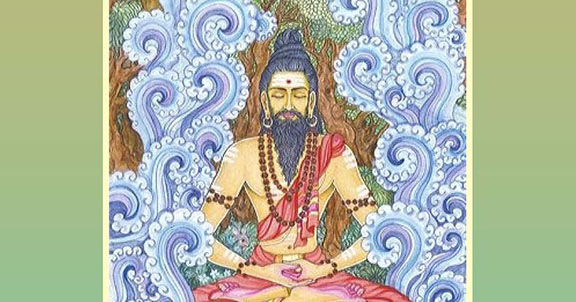 Svatmarama Suri also mentions 72,000 nadis and claims only sushumna nadi is of importance. He describes many methods of achieving the samadhi state. He puts most emphasis on the use of nada, or inner sound. He says, “The primeval Lord Shiva has expounded one crore [10 million] and a quarter of effective ways for the attainment of laya (absorption) but we think that one thing, devotion to nada alone, is the most important of all these ways” (4.66).
Svatmarama Suri also mentions 72,000 nadis and claims only sushumna nadi is of importance. He describes many methods of achieving the samadhi state. He puts most emphasis on the use of nada, or inner sound. He says, “The primeval Lord Shiva has expounded one crore [10 million] and a quarter of effective ways for the attainment of laya (absorption) but we think that one thing, devotion to nada alone, is the most important of all these ways” (4.66).
Again he says, “Nada is like the net which ensnares the deer (the mind) and it is also the hunter who slays the deer within (the mind)” (4.94). He describes many aspects of Nada Yoga and also samadhi. Svatmarama Suri concludes his work with: “As long as the prana does not flow in the central way (through sushumna) and enter the brahmarandhra, as long as the semen does not become steady through restraint of breath, so long as the mind does not in meditation reflect the natural state (of the object contemplated upon, i.e. Brahman), so long as those who talk of spiritual knowledge indulge only in boastful and false prattle [there is no success in Yoga]” (4.114).
In the Hatha Yoga Pradipika, unlike other texts discussed thus far, much practical instruction is given in asanas, pranayama, mudras, and even in methods of attaining samadhi. Yet, the instruction given is couched in difficult and deliberately obscure language. It is not a textbook on Yoga, and Yoga practices could not be undertaken merely on the basis of studying the text because the references are far too obscure and too ambiguous. The Guru himself makes many references, throughout the work, to the need for the practices to be kept secret. If he intended his work to be used as a practical guide to practices, he would never have written them down, violating his own cautions.
Like all ancient Gurus, the written aspect of the teaching was only the tip of the iceberg, a jolt to the memory of the student, a reminder of the whole and not containing the whole within itself. For example, he says, “The yogi desirous of obtaining siddhi should keep the Hatha Yoga very secret. For it is potent when kept secret and ineffective when injudiciously revealed” (1.11). He also stresses, time and again, the need for the direct guidance of the Guru: “There is an excellent karana by which the sun is duped. This should be learnt from the Guru and not through the study of the shastras” (3.78). Later, he declares, “Who really knows the greatness of Raja Yoga? Jnana, mukti, sthiti and siddhi are obtained through the teaching of the Guru” (4.8).
Though this text does appear to give detailed instructions in asanas, pranayama, mudras, and the means of practicing dhyana, in reality, the references are very obscure and deliberately kept ambiguous, forcing the sincere aspirant not to rely on the text alone, but to seek the guidance of a qualified master.
Hatha Yoga is the appropriate sadhana for Kali Yuga, an age in which human beings have lost control over their bodies, emotions, and sensual organs. Hatha Yoga allows the practitioner to use the body as a stepping-stone toward higher evolutionary levels. The body then becomes an instrument, rather than a hindrance, toward achieving the noble aim of life—moksha (liberation).
About the Authors: Yogacharini Meenakshi Devi Bhavanani and Yogacharya Dr. Ananda Balayogi Bhavanani
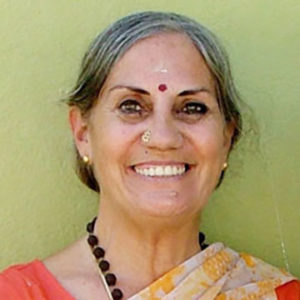
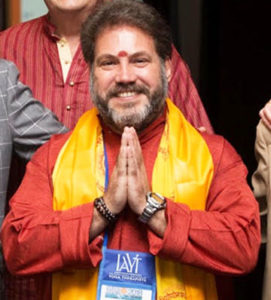 The International Centre for Yoga Education and Research (ICYER), located near Pondicherry in South India, is directed by Yogarcharini Meenakshi Devi Bhavanani. She is ably assisted by her son, Yogacharya Dr. Ananda Balayogi Bhavanani, an accomplished musician, Yoga teacher and medical doctor. The ICYER is the umbrella organization for a group of sub-organizations that represent the institution in different fields including classical South Indian arts, Yoga publications, and the Yoga Jivana Satsangha, with 120 Gitananda Yoga Centers in 22 countries. For more information, please visit: www.icyer.com.
The International Centre for Yoga Education and Research (ICYER), located near Pondicherry in South India, is directed by Yogarcharini Meenakshi Devi Bhavanani. She is ably assisted by her son, Yogacharya Dr. Ananda Balayogi Bhavanani, an accomplished musician, Yoga teacher and medical doctor. The ICYER is the umbrella organization for a group of sub-organizations that represent the institution in different fields including classical South Indian arts, Yoga publications, and the Yoga Jivana Satsangha, with 120 Gitananda Yoga Centers in 22 countries. For more information, please visit: www.icyer.com.

